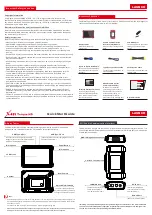
MF
MF
MF
MF
MF
MF
MF
MF
MF
INCOMING
G
N
I
O
G
T
U
O
G
N
I
O
G
T
U
O
E
I
T
_
S
U
B
E
I
T
-
S
U
B
G
N
I
O
G
T
U
O
G
N
I
O
G
T
U
O
INCOMING
MEASUREMENT
PH3LPTOC
PH3HPTOC
PH3IPTOC
CCBRBRF
INRPHAR
PH3LPTOC
PH3HPTOC
PH3IPTOC
CCBRBRF
PH3LPTOC
PH3HPTOC
PH3IPTOC
CCBRBRF
Blocking output
(Outgoing feeder
PH3HPTOC START)
Blocking output
(Outgoing feeder
PH3HPTOC START)
PH3LPTOC
PH3HPTOC
PH3IPTOC
CCBRBRF
B
L
O
C
K
i
n
Blocking output
(PH3HPTOC
START)
B
L
O
C
K
i
n
PH3LPTOC
PH3HPTOC
PH3IPTOC
CCBRBRF
INRPHAR
BL
O
C
K
i
n
BL
O
C
K
i
n
Blocking output
(PH3HPTOC
START)
B
LO
CK
i
n
HV-side
LV-side
HV-side
LV-side
MEASUREMENT
Figure 130: Numerical overcurrent protection functionality for a typical sub-
transmission/distribution substation (feeder protection not shown). Blocking
output = digital output signal from the start of a protection stage, Blocking in =
digital input signal to block the operation of a protection stage
The operating times of the time-selective stages are very short, because the
grading margins between successive protection stages can be kept short. This is
mainly due to the advanced measuring principle allowing a certain degree of CT
saturation, good operating accuracy and short retardation times of the numerical
units. So, for example, a grading margin of 150 ms in the DT mode of operation can
be used, provided that the circuit breaker interrupting time is shorter than 60 ms.
The sensitivity and speed of the current-selective stages become as good as
possible due to the fact that the transient overreach is very low. Also, the effects
of switching inrush currents on the setting values can be reduced using the IED
logic which recognizes the transformer-energizing inrush current and blocks the
operation or multiplies the current start value setting of the selected overcurrent
stage with a predefined multiplier setting.
Finally, a dependable trip of the overcurrent protection is secured by both
a proper selection of the settings and an adequate ability of the measuring
transformers to reproduce the fault current. This is important in maintaining
selectivity and also for the protection to operate without additional time delays. For
additional information about available measuring modes and current transformer
requirements, see
Chapter 11.5 Measurement modes
in this manual.
Radial outgoing feeder overcurrent protection
The basic requirements for feeder overcurrent protection are adequate sensitivity
and operation speed taking into account the minimum and maximum fault current
1MRS757644 H
Protection functions
620 series
Technical Manual
265
















































